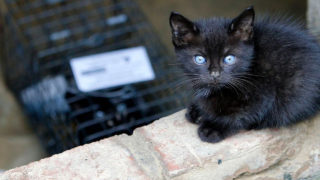For ten years, from 1998 to 2007, Alley Cat Allies founded, funded, and operated a subsidized, monthly spay/neuter clinic in Northern Virginia for feral cats all over the region. The clinic ran 110 “˜spay days’ and served more than 6,500 cats from four statesDelaware, Maryland, Virginia, and West Virginiaand the District of Columbia.
The clinic was staffed by volunteers and veterinarians who provided their services pro bono. There was no cost to people bringing in cats, though they were asked for a donation. These donations helped cover approximately one-third of the operational cost of the clinic. As part of the protocol for this model clinic, we collected data about each cat, including:
- Colony location
- Health status
- Gender
- Reproductive status (neutered, intact, pregnant)
- Outcome (returned, adopted, other)
- Information about the caregiver or trapper bringing in the cat
Highlights
The data from our clinic is consistent with other peer-reviewed studies of feral cat spay/neuter clinics all over the country98% of cats brought to the clinic over the ten year period were returned to their outdoor home. Another 1% had positive outcomes. The data also confirms that feral cats live healthy lives outdoors: less than half of a percent were euthanized due to medical issues.
Findings
The population of cats admitted at our clinic is what other clinics have received upon intake:
- Slightly more female cats came through the clinic than male cats. Of the 6,482 cats whose gender was recorded, 54% were female, while approximately 46% were male.
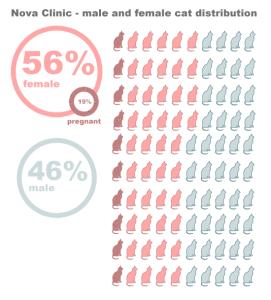
- Nearly one in five female cats was pregnant. Over the course of the entire ten year period, 19% of all female cats brought into the clinic were pregnant. The average number of pregnant queens varied depending on the season, peaking in March each year. Over ten years, more than half of all female cats brought to the clinic in March were pregnant (56%). This monthly average dropped down to less than one percent in October, November, and December each year.ii The pattern we observeda single peak in earlier spring followed by a lesser peak in the summeris very similar to statistics from other spay/neuter clinics.1,2,3
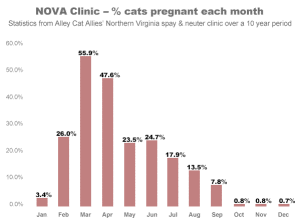
- Very few cats were already spayed or neutered. Of 6,512 total cats, only 2% were found to be already spayed or neutered when they arrived at the clinic. The remaining cats were almost all spayed or neutered at the clinic (97%). Only one percent was not neutered due to a medical condition or other reason.
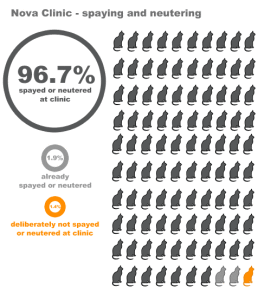
- Nearly all cats were returned to their outdoor home. Of the more than 6,500 cats brought in to the clinic over ten years, 98% (6,389 cats) were returned to their habitat outdoors. Another 1% had positive outcomes: they were socialized cats who were adopted into homes (0.8%, 50 cats) or relocated (.3%). Less than one percent were euthanized due to medical issues (an animal is euthanized only when she is hopelessly sick or injured), died during the procedure at the clinic, or had to be quarantined. A small number of cats (0.3%, 19 cats) did not have recorded outcomes in the records.
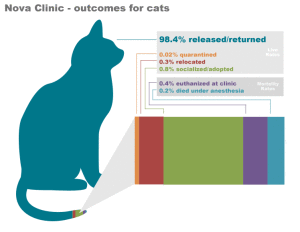
- Feral cats are healthy members of our communities. Over ten years, less than half of one percent, or 24 cats out of 6,512 seen at the clinic, were euthanized due to medical issues. Learn more about feral cat health. Feral cat spay/neuter clinics improve the lives of cats by ending reproduction and stopping the behaviors and stresses associated with matingpregnancy, yowling, and fighting. While Alley Cat Allies improved the lives of more than 6,500 cats during the span of our clinic, we also used it as an opportunity to gather significant data about the feral cat population. The data from our clinic is consistent with the findings in other, peer-reviewed studies on other feral cat spay/neuter clinics showing that feral cats live healthy lives in their outdoor homes.4,5,6
- The gender of a small number of cats was not recorded (0.5%, 30 cats).
- Four months between 1/1999 and 12/2007 had no clinics: 6/1999, 7/2002, 12/2004, and 11/2007.
- Scott, Karen C., Julie K. Levy and P. Cynda Crawford. Characteristics of free-roaming cats evaluated in a trap-neuter-return program/ Journal of the American Veterinary Medical Association 2002; 221(8): 1136 1138.
- Nutter, Felicia B., Jay F. Levine and Michael K. Stoskopf. Reproductive capacity of free roaming cats and kitten survival rate. Journal of the American Veterinary Medical Association 2004; 225(9): 1399 1402.
- Wallace, Jennifer L. and Julie K. Levy. Population characteristics of feral cats admitted to seven trap-neuter-return programs in the United States. Journal of Feline Medicine and Surgery 2006; 8: 279 284
- Scott, Karen C., Julie K. Levy and P. Cynda Crawford. Characteristics of free-roaming cats evaluated in a trap-neuter-return program/ Journal of the American Veterinary Medical Association 2002; 221(8): 1136 1138.
- Nutter, Felicia B., Jay F. Levine and Michael K. Stoskopf. Reproductive capacity of free roaming cats and kitten survival rate. Journal of the American Veterinary Medical Association 2004; 225(9): 1399 1402.
- Wallace, Jennifer L. and Julie K. Levy. Population characteristics of feral cats admitted to seven trap-neuter-return programs in the United States. Journal of Feline Medicine and Surgery 2006; 8: 279 284.

